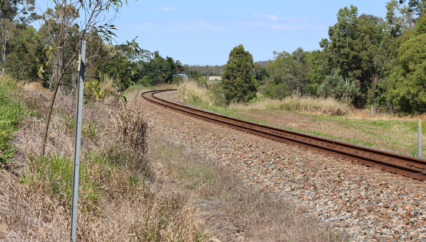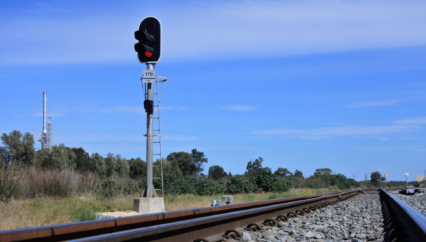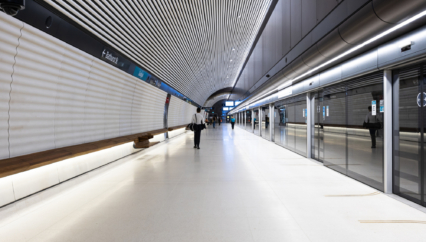Safety messages
Safety messages are published by ONRSR periodically and are designed to focus on specific areas of rail safety concern, to share information between the regulator and the rail industry, and to identify positive steps to enhance rail safety.

Safety Message – Temporary Jumpers and Bridges
Temporary jumpers or bridges are electrical wires railway signalling personnel use to bypass or isolate portions of signalling apparatus, circuitry or equipment to enable rail construction or maintenance works.

Safety Message – Managing Track Stability
Track stability refers to track resistance to lateral movement, such as curves pushing out or buckling during hot weather, and/or curves pulling in when conditions are cooler. Track stability management applies equally to continuously welded rail (CWR), long welded rail (LWR) and jointed track.

Safety Message – Risk registers
Risk registers record information about risks to your railway operations and are a requirement under the Rail Safety National Law (RSNL) and Rail Safety National Law National Regulations (RSNLNR).

Safety Message – Maintenance of train detection systems
In the last three years more than 30 incidents involving failures of train detection systems, have been reported to ONRSR. These incidents have included short warnings at level crossings, non-operation of level crossing equipment, derailments, and other signalling issues such as wrong side failures.

Safety Message – Long Term Effective Controls
In previous safety messages, ONRSR has provided information about rail incidents and the many controls available to eliminate or minimise the risk of these incidents occurring. In this safety message, we provide a non-exhaustive list of controls that can reduce the risk of not just one, but many types of rail incidents.
Safety Message: Track Obstructions
Failing to put in place controls to adequately protect the railway from track obstructions can result in serious incidents such as collisions and derailments.
Safety Message: Installing, Upgrading and Commissioning Signalling Assets
Signalling systems are critical pieces of infrastructure that are fundamental to the safe operation of railways across Australia. As such, the full scope of these systems, from introduction to ongoing maintenance must be carefully and systematically managed.
Safety Message: Rolling stock net braking ratio testing
ONRSR is reminding all accredited operators that freight wagons must have the designed net braking ratio (NBR)* throughout their service lives to reduce the risk of failures that could lead to a runaway and or a derailment.
Safety Message: Level Crossings and the Importance of Ongoing Risk Assessment - Part 2
In this second part of ONRSR’s focus on level crossing safety, we provide further details on the good practices ONRSR has observed regarding the management of risk at level crossings, including risk assessments, ongoing monitoring and review of controls and managing interface agreements.
Safety Message: Level Crossings and the Importance of Ongoing Risk Assessment
The need to continually assess operational risks to ensure chosen controls are effective in managing rail safety has been highlighted in recent regulatory activity. This safety message focuses on level crossings and highlights a specific example where ONRSR, a road manager, and a rail transport operator collaborated to identify actions which will make a complex metropolitan level crossing safer for road and rail users.
Safety Message: Dark Signals and Mixed Mode Operations
With the development of new signalling technologies, railways across Australia are adopting advanced signalling systems such as ETCS (European Train Control System) and CBTC (Communication Based Train Control) onto existing lines. The rollout of these technologies may require an ‘interim interoperability solution’ to allow operations to continue through the transition and implementation period.
Safety Message: Authority Gradients
Effective safety critical communication is fundamental to any rail transport operator’s (RTO) safety management system. While there have been marked improvements in industry performance in this space, ONRSR’s data and infield insights tell us communication continues to be a factor in many reportable occurrences.
Safety Message: Digital re-creation #8 - Track Occupations
ONRSR’s latest digital incident recreation focuses on how rail transport operators and rail infrastructure managers can safeguard against the risks posed by large scale maintenance works in the vicinity of live railways.
Safety Message: Promoting a Positive Safety Culture - Part 2
In this second part of ONRSR’s focus on safety culture, we continue to look at practical steps rail transport operators can take to promote a positive safety culture, as required by the Rail Safety National Law. [Clause 3 of Schedule 1 of the Rail Safety National Law National Regulations]
Safety Message: Promoting a Positive Safety Culture
Safety culture is the way safety is perceived, valued, and prioritised in an organisation. It is a result of individual and group values, attitudes, perceptions, competencies, and behaviour that determine the commitment to, and proficiency of, an organisation’s health and safety management.
Safety Message: Safety Assurance of Contracted Maintenance
ONRSR wants Rail Transport Operators to renew their focus on the quality assurance processes they have in place to ensure contracted maintenance work is carried out safely and effectively.
Safety Message: Emergency Management Plans (EMP)
An Emergency Management Plan (EMP) is a written set of instructions outlining how a rail transport operator can manage emergencies including fires, collisions, derailments and evacuations.
Safety Message: Management of change
During regulatory activities and interactions, ONRSR identifies both good and poor practice when operators undertake changes to their railways.
Safety Message: Pre-possession Planning Meetings
A current ONRSR investigation has highlighted a concerning issue where safety critical staff such as protection officers are not attending pre-possession planning meetings.
Safety Message: Type Approval
During regulatory activities and interactions, ONRSR identifies both good and poor practice regarding rail equipment type approval.
Safety Message: Investigating incidents
During regulatory activities and interactions, ONRSR identifies both good and poor practice from rail operators’ investigations reports.
Safety Message: Altered Working Arrangements
ONRSR investigations and those conducted by other regulatory authorities have identified both good and poor practice when managing risks that arise when unexpected changes occur during railway operations.
Safety Message: Human Factors in maintenance
In this safety message, ONRSR is highlighting some of the ways rail transport operators and rail infrastructure managers can apply a human factors lens to maintenance.
Safety Message: Ageing infrastructure
ONRSR is growing increasingly concerned about the prevalence of ageing infrastructure on Australian railway networks and is calling on operators to work closely with it to find appropriate solutions to address the issue.
Safety Message: Digital re-creation #6 - Braking procedures and capability
ONRSR’s latest digital incident re-creation is based on a potentially disastrous incident that highlights the need for absolute vigilance in adhering to the fundamentals of a safety management system.
Safety Message: Managing your signalling assets
ONRSR is highlighting some of the key good practices and requirements for effective management of railway Signalling, Communications, Electrical and Control Systems (SCE&CS).
Safety Message: Managing your rolling stock assets
ONRSR is highlighting some of the key good practices and requirements for effective management of freight and passenger rolling stock.
Safety Message: Managing your track infrastructure assets
ONRSR is highlighting good practices and requirements for effective management of railway track infrastructure
Safety Message: Managing your bridge assets
ONRSR is highlighting some of the key good practices and requirements for effective management of railway bridges.
Safety Message: Lineside fires
ONRSR is highlighting the risk of lineside fires and detailing a range of effective controls.
Safety Message: Runaways within and from yards and sidings
ONRSR is highlighting the risk of rolling stock runaways in yards and sidings and detailing a range of effective controls.
Safety Message: Risk assessments undertaken as administrative tasks
In conducting ONRSR’s regulatory activities, ONRSR has found that some operators are undertaking a risk assessment as an administrative task or hurdle rather than as a process to support or guide their decision-making.
Safety Message: Deviating from procedures and standards
ONRSR is highlighting the dangers of straying from documented processes when designing and maintaining operations and infrastructure.
Safety Message: Sandbox maintenance
As the saying goes, what can go wrong will go wrong and it’s this reality ONRSR wants rail transport operators to more actively consider when assessing what have been generally low safety risks.
Safety Message: The Dangers of Reprioritising Defects
ONRSR conducts regulatory activities, including audits, inspections and site visits, across multiple operators and sectors. In conducting these activities, ONRSR often observes and identifies common safety themes and issues. In this series of safety messages, ONRSR highlights these issues, how they can potentially increase risks to rail safety and what better practice can look like to minimise the potential risks.
Safety Message: Ad hoc systems and procedures vs Safety Management Systems
In this safety message - the first in a new series - ONRSR identifies a number of potential scenarios whereby informal or ad hoc processes and procedures can undermine a safety management system and create safety issues.
Safety Message: Digital re-creation #5 - Authority gradients and safety culture on worksites
ONRSR’s first digital incident re-creation of 2022 details what can go wrong when safety culture is eroded and safety systems are not prepared, explained and executed correctly.
Safety Message: Fires in tunnels and underground stations
ONRSR is reminding rail transport operators about a range of risks, causes and controls associated with fires in underground tunnels and stations (FTUGs).
Safety Message: Fires on passenger rolling stock
ONRSR is reminding rail transport operators (RTOs) about a range of risks, causes and controls associated with fires and explosions on passenger rolling stock.
Safety Message: Sticking brakes
ONRSR is reminding rail transport operators about a range of risks, causes and controls associated with sticking brakes on all types of rolling stock.
Safety Message: Falls between the platform and train
ONRSR is reminding rail transport operators about a range of risks, causes and controls associated with passenger falls between the platform and train.
Safety Message: Network Controllers and Runaways
ONRSR is asking those rail transport operators (RTOs) – with Network Control centres – to ensure network controllers are properly trained in the event of runaway incidents.
Safety Message: Rail bridges struck by road vehicles or vessels
ONRSR is reminding rail transport operators about a range of risks, causes and controls associated road vehicles or vessels striking rail bridges.
Safety Message: Digital recreation #4 - SPADs: managing the risks SFAIRP
ONRSR is reminding operators of the importance of managing the risks of SPADs and what the consequences of not doing so can potentially lead to.
Safety Message: Short Warning Times (overspeed or procedural breaches)
ONRSR is reminding rail transport operators about a range of risks, causes and controls associated with short warning times at level crossings caused by train overspeed or procedural breaches.
Safety Message: Short warning times (wheel-rail interface issues)
ONRSR is reminding rail transport operators about a range of risks, causes and controls associated with short warning times at level crossings caused by wheel-rail interface issues.
Safety Message: 'A1 SPADs’ – Limit of authority missed by train crew
Note: As a result of the National Rail Safety Data Strategy implementation, from 1 July 2022, A1 SPADs are Category A Proceed Authority Exceedances. Further information about reporting and occurrence data submission requirements can be found here
Safety Message: Train to train collisions - risks, causes & controls
ONRSR is reminding rail transport operators about a range of risks, causes and controls associated with train to train collisions.
Safety Message: Digital recreation #3 - Worksite protection incident recreation & learnings
ONRSR’s first digital animation for 2021 focuses on a worksite protection occurrence and provides key learnings and advice for operators in relation to work on track.
Safety Message: Wabtec Air Brake System – advice to rail transport operators
An ONRSR investigation into a recent runaway incident revealed a feature of the Wabtec air brake system that is now highlighted to rail transport operators.
Safety Message: Preparedness and Awareness - Know Your Operation and Kit
The systems, machinery, hardware and software used to run rail operations are often necessarily complex, but ONRSR is becoming increasingly aware that operators are not always fully aware of the detailed operational specifications of their many and varied pieces of kit.
Safety Message: Track Worker Safety National Priority Project Update
ONRSR identified track worker safety as one of its inaugural national priorities in 2016, ensuring the issue was the subject of a sustained period of regulatory attention.
Safety Message: Digital recreation #2 - Uncontrolled wagon movement
In this, ONRSR’s second digital re-creation, we look at the issue of uncontrolled movements and what happens when rail safety workers take shortcuts and ignore processes and protocols.
Safety Message: Network Controller competencies
ONRSR is advising operators to assess competency of network controllers following an emerging trend.
Safety Message: Emergency communications and readiness
Training for an emergency situation is important so that it becomes routine, as much as possible.
Safety Message: Digital recreation #1 - Safety critical communication
This digital recreation explores the issue of a communications breakdown that resulted in a near miss for a track worker
Regulating during COVID-19 - Freight
Regardless of the current circumstances, the principles of risk management, risk control, and active supervision continue to be a legal and critical requirement even if there is a need to perform work in different conditions.
Safety Message: Rail Safety Officers: Powers under Rail Safety National Law
ONRSR’s rail safety officers (RSOs) are our primary interface with accredited rail transport operators and they are based in each of our offices around the country
Safety Message: Safety Management System Case Study - ONRSR and ASSCO
ONRSR recently worked with the Australian Society of Section Car Operators to address an outdated safety management system and safety culture. The experience serves as an important reminder to all rail transport operators to ensure safety is always the top priority
Safety Message: Load distribution for Road Rail Vehicles
rail transport operators are reminded that wheel loads effect safe guidance of vehicles on track with excessive loads leading to damaged rolling stock components and track structures.
Lessons Learned: ONRSR & GWA - Whyalla Runaway Incident
This document shares findings made from a runaway incident that occurred on 31 July 2019 in Whyalla, South Australia that should be used as an input to the risk review processes for operators managing a similar operating scenario.
Safety Message: Passengers caught in rolling stock doors - Risks, causes and controls
ONRSR has developed new guidance for rail transport operators about the potential causes of incidents where people get stuck in rolling stock doors. It includes information regarding the existing controls available to eliminate or minimise the risk.
Safety Message: Track Condition and Derailment Risk
ONRSR is emphasising to all Rail Infrastructure Managers (RIMs) the increased risks posed by poorly maintained track following a series of recent derailments.
Safety Message: ONRSR Investigation Findings: Worksite Protection Incidents
ONRSR is reminding all operators of the importance of careful planning when carrying out Track Occupancy Authority and Local Possession Authority activities.
Safety Message: Unsafe Loading of Coal Wagons
This safety message is directed to coal loading operators and any other rolling stock operators responsible for loading coal into wagons.
Safety Message: Importance of a System Engineering Approach
Following recent incidents and observations the Office of the National Rail Safety Regulator (ONRSR) is reminding all operators of the importance of a system engineering approach.
Safety Message: Rolling Stock Maintenance - November 2018
Following recent incidents, and a review of the Office of the National Rail Safety Regulator’s own compliance and inspection activities, ONRSR is reminding all operators of the important role rolling stock maintenance plays in avoiding safety critical component failures.
Safety Message: Fatigue risk management programs and enterprise bargaining agreements
Some rail transport operators (RTO) may choose to apply arrangements from enterprise bargaining agreements to their fatigue risk management program. In this instance there are strict obligations that an RTO’s safety management system must meet.
Management of emergency working (unplanned works)
ONRSR reminds all rail transport operators to be aware of the inherent risks associated with undertaking emergency or unplanned maintenance.
Safety Message: Management of emergency working (unplanned works)
ONRSR is reminding all rail transport operators to be aware of the inherent risks associated with undertaking emergency or unplanned maintenance.
Safety Message: ATSB investigation report findings on use of bio-mathematical models of human fatigue – learnings for the rail industry
An ATSB-identified limitation of use of the bio-mathematical model FAID has relevance to the rail industry.
Asbestos found in imported friction wear plates in rail carriages – WA Government alert
Asbestos has recently been found in friction wear plates in the suspension systems of rail carriages.
Technical Review: Wheel Failure Incidents and Other Data in the Hunter Valley: 2013–2015
A review of the metallurgical and associated factors covering eight wheel failure incidents, issued for the benefit of like-for-like railways.
Technical Review: Wheel Failure Incidents and Other Data in the Hunter Valley: 2013–2015
Sets out ONRSR's road rail vehicle (RRV) human factors observations and analyses.
Safety Message: Preventing unbraked runaways of permanently coupled wagons with shared braking platforms
The ONRSR is concerned about the risk of permanently coupled pairs of freight wagons, which share a braking system, becoming uncoupled and resulting in a runaway. Rail operators are expected to reassess the risk/s associated with permanently coupled wagons and consider additional measures to mitigate these risks.
Safety Message: An emerging issue: 'shattered rim' wheel defects
Australian rail operators may need to review and revise risk registers to manage the hazards associated with ‘shattered rim’ following two recent incidents, which may be indicators of a larger safety issue for the industry.
Safety Message: Learning lessons from international rail incidents
Investigation reports into rail accidents overseas can provide valuable lessons learned which, when applied, may reduce the risk of these incidents occurring in Australia.
Safety Message: Managing the risks associated with roadrail vehicles
The ONRSR has been working closely with the rail industry to assist in the identification and management of risks associated with the operation of Road/Rail Vehicles (RRVs).